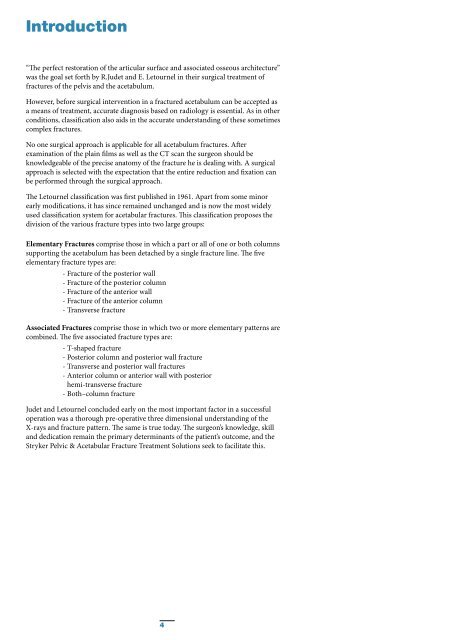Pelvic & Acetabular Fracture Treatment - Stryker
Pelvic & Acetabular Fracture Treatment - Stryker
Pelvic & Acetabular Fracture Treatment - Stryker
You also want an ePaper? Increase the reach of your titles
YUMPU automatically turns print PDFs into web optimized ePapers that Google loves.
Introduction<br />
“The perfect restoration of the articular surface and associated osseous architecture”<br />
was the goal set forth by R.Judet and E. Letournel in their surgical treatment of<br />
fractures of the pelvis and the acetabulum.<br />
However, before surgical intervention in a fractured acetabulum can be accepted as<br />
a means of treatment, accurate diagnosis based on radiology is essential. As in other<br />
conditions, classification also aids in the accurate understanding of these sometimes<br />
complex fractures.<br />
No one surgical approach is applicable for all acetabulum fractures. After<br />
examination of the plain films as well as the CT scan the surgeon should be<br />
knowledgeable of the precise anatomy of the fracture he is dealing with. A surgical<br />
approach is selected with the expectation that the entire reduction and fixation can<br />
be performed through the surgical approach.<br />
The Letournel classification was first published in 1961. Apart from some minor<br />
early modifications, it has since remained unchanged and is now the most widely<br />
used classification system for acetabular fractures. This classification proposes the<br />
division of the various fracture types into two large groups:<br />
Elementary <strong>Fracture</strong>s comprise those in which a part or all of one or both columns<br />
supporting the acetabulum has been detached by a single fracture line. The five<br />
elementary fracture types are:<br />
- <strong>Fracture</strong> of the posterior wall<br />
- <strong>Fracture</strong> of the posterior column<br />
- <strong>Fracture</strong> of the anterior wall<br />
- <strong>Fracture</strong> of the anterior column<br />
- Transverse fracture<br />
Associated <strong>Fracture</strong>s comprise those in which two or more elementary patterns are<br />
combined. The five associated fracture types are:<br />
- T-shaped fracture<br />
- Posterior column and posterior wall fracture<br />
- Transverse and posterior wall fractures<br />
- Anterior column or anterior wall with posterior<br />
hemi-transverse fracture<br />
- Both–column fracture<br />
Judet and Letournel concluded early on the most important factor in a successful<br />
operation was a thorough pre-operative three dimensional understanding of the<br />
X-rays and fracture pattern. The same is true today. The surgeon’s knowledge, skill<br />
and dedication remain the primary determinants of the patient’s outcome, and the<br />
<strong>Stryker</strong> <strong>Pelvic</strong> & <strong>Acetabular</strong> <strong>Fracture</strong> <strong>Treatment</strong> Solutions seek to facilitate this.<br />
4

















